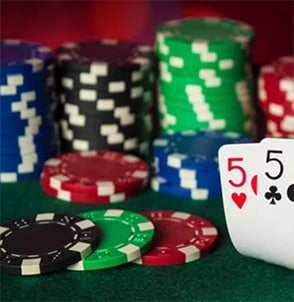Ever found yourself mesmerized by the enigma of a poker game, wondering how to perfect your strategy? The answer is as subtle as a stroke with a single-bristled brush, yet as powerful as the whole canvas: Polarized Ranges. And no, this isn’t about picking the perfect pair of sunglasses, though we must admit that a good poker face can be accentuated by some stylish eyewear!
Polarized ranges in poker refers to the selection of hands that either fall into the category of very strong or very weak. It’s a strategy that’s as polarized as public opinion on pineapple on pizza (obviously it’s a yes)! So why exactly would you want to reveal such extremes in your poker game?
Well, consider this. When you polarize your range, you keep your opponents guessing. It’s like playing hide and seek in a mansion – there are just so many places to hide! It’s the suspense that keeps the game interesting. It’s the heartbeat that keeps the excitement alive.
Your opponents will never know whether you’re holding a monster hand or a bluff. And in that uncertainty lies your advantage. Who knew that mystery could be so beneficial, right?
Yin and Yang
Hand selection in poker is more than just a tactical move – it’s an art. And like any good artist, you need to understand the balance between extremes. Imagine a painting without contrast, wouldn’t it be boring? Similarly, having a balanced poker strategy is all about mixing it up.
On one end of the spectrum, we have premium hands – the Aces and Kings of your deck. These are the hands you’d bet your house on. On the other end, we have the bluffing hands – the ones you’d rather not show your opponents. Balancing between these two extremes is where the magic happens.
![]()
Think about it – if you only played premium hands, your strategy would become as predictable as a rom-com ending. And if you bluffed too often, well, you’d probably be as broke as a college student on spring break. The trick is to walk the tightrope of unpredictability.
Remember, you don’t always have to win. Sometimes, the value lies in the play, not the outcome. A lost bluff could set you up for a big win later, much like the caterpillar’s struggle gives way to the butterfly’s flight.
Building a Fortress with a Balanced Poker Strategy
Crafting a balanced poker strategy is a bit like building a castle. You need a strong foundation (knowledge of the game), the right stones (a good selection of hands), and a killer design (an unpredictable strategy). Now, let’s break it down.
The foundation is your understanding of the game. Are you well-versed with the rules? Do you know when to fold and when to raise? Understanding the basics is as crucial as knowing the lyrics to your national anthem.
Next come the stones – your hand selection. Just as no two stones are identical, no two hands are the same. The art of poker lies in recognizing the potential in each hand, much like a sculptor sees a masterpiece in a block of marble.
Finally, the design. This is where the polarized ranges come into play. The unpredictability of your moves will keep your opponents second-guessing, making your strategy as mesmerizing as the Northern Lights.
Remember, the path to a balanced poker strategy is a journey, not a sprint. It’s about learning from each move, each game, each win and loss.
Kaleidoscope of Psychology
The world of poker is a kaleidoscope of psychology, risk, and strategy. It’s a dance between math and intuition, a symphony of skill and luck. And like any good composer, you need to know when to introduce each note, each pause, each crescendo.
Understanding the psychology of your opponents is crucial. Are they aggressive or conservative? Do they play safe or take risks? Each player is a unique piece of the puzzle, and understanding their game can be as enlightening as the end of a Sherlock Holmes novel.
Remember, poker isn’t just a card game. It’s a game of minds. The real battle happens not on the felt table, but in the minds of the players. And mastering the art of poker psychology is like having the key to the city of your opponent’s mind.
The Balance of Betting and Bluffing
Betting and bluffing in poker is a delicate dance. It’s all about timing and precision, much like baking the perfect soufflé. Bet too high, and you might scare away your opponents. Bluff too often, and you’ll earn a reputation faster than a cat video goes viral.
A good bluff is like a plot twist in a thriller movie. It should be unexpected, yet believable. You want to create a story that your opponents will buy into, but also throw in a surprise ending. Remember, it’s not about the cards you’re dealt, but how you play them.
Betting, on the other hand, is about assessing the value of your hand, the risks involved, and the potential payoff. It’s a delicate equation, as intricate as a game of chess. The key is to find the sweet spot – bet enough to keep the game interesting, but not so much that you risk losing it all.

The Final Stroke: Putting It All Together
The art of polarized ranges isn’t about being reckless or overly cautious. It’s about understanding the balance, the dance between risk and reward. It’s about mixing it up, keeping your opponents guessing, and playing the game, not just the cards.
Developing a balanced poker strategy isn’t a one-time event. It’s an ongoing process, a constant evolution. Like the seasons, your strategy will change, adapt, and grow. And that’s what makes it as exhilarating as the first drop on a roller coaster.
So, whether you’re a seasoned poker veteran or a curious novice, remember that the art of poker lies not just in winning, but in the journey. In the words of the great Winston Churchill, “Success is not final, failure is not fatal: it is the courage to continue that counts.”
So here’s to the courage to continue, to the thrill of the game, and to the endless quest for the perfect poker strategy. Because at the end of the day, poker is not just a game of chance, it’s a game of skill, strategy, and, above all, balance.
Remember, the canvas of your poker strategy is yours to paint. So grab your brushes, embrace the art of polarized ranges, and create your masterpiece. Who knows, your next game could be your Sistine Chapel. Good luck, and may the odds be ever in your favor!

